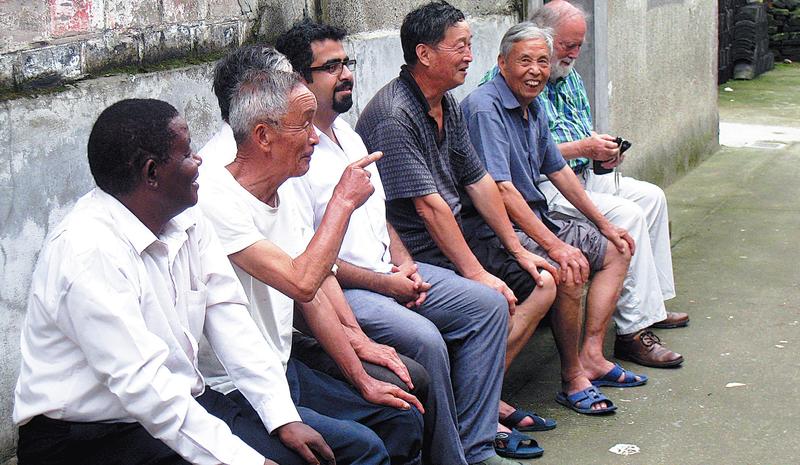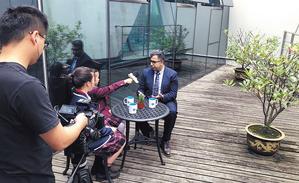Academic develops a resilience framework to help Ningbo face, and recover from, the COVID-19 outbreak and future challenges, Yang Feiyue reports.
 Ali Cheshmehzangi and his international collaborators during their visit to rural areas around Ningbo in 2014. (PHOTO PROVIDED TO CHINA DAILY)
Ali Cheshmehzangi and his international collaborators during their visit to rural areas around Ningbo in 2014. (PHOTO PROVIDED TO CHINA DAILY)
Professor Ali Cheshmehzangi didn't idle away his time in isolation at his home in Ningbo, eastern Zhejiang province.
If anything, he was busier than usual.
The British-Iranian professor has applied his expertise to help the city of Ningbo during the COVID-19 outbreak.
He spent 20 days at home developing a comprehensive urban resilience framework and delivered it to the local government on Feb 10.
"My sole intention was to help the city where I live," Cheshmehzangi says.
The idea was to assist local authorities in protecting citizens during the outbreak and ensure that life returns to normal as swiftly as possible after it.
Cheshmehzangi is an associate professor in architecture and urban design at the University of Nottingham Ningbo China, and specializes in urban growth and development from the perspectives of urban transition and urban sustainability.
"This framework is intended to aid the city administration's decision-making by evaluating two key categories-management and provision-with the former looking at institutional and operational aspects, and the latter at service and supply," Cheshmehzangi says.
According to the framework, each of the categories is divided into the specific systems that are essential to the city, including healthcare, food supply and transportation. Each of them are assessed for their resilience, both during the epidemic and in the post-epidemic recovery phase.
He says he had the idea on Jan 25, when the coronavirus outbreak in Wuhan was starting to attract national attention. The framework was developed on Feb 2.
Cheshmehzangi spent the first few days observing the situation and how it was developing.
He drove around key areas in one or two districts, observing and recording a variety of sites, including hospitals, business areas, commercial and retail, residential, and educational areas.
"The intention was to ensure an accurate reflection of the realities of the city, to ensure the framework is all-inclusive and practical," he says.
Cheshmehzangi checked what measures were in place or where they were needed, and the existing impact on the multiple sectors and systems of the city.
He then proposed suggestions for things, such as management of entry and exits to public places, public mobility and group gatherings.
 Cheshmehzangi is interviewed by a local TV in Ningbo on the promotion of green buildings and green technologies in China. (PHOTO PROVIDED TO CHINA DAILY)
Cheshmehzangi is interviewed by a local TV in Ningbo on the promotion of green buildings and green technologies in China. (PHOTO PROVIDED TO CHINA DAILY)
Cheshmehzangi also prepared for the worst possible scenario in his framework, which was to have neighborhood-level provision of special medical units specifically for receiving and treating suspected cases and infected patients.
"This is to ensure the regular operations of hospitals are fully maintained," he says.
He felt relieved that the city's situation did not worsen any further, thanks to the precautionary measures taken by the local government.
Ningbo had less than 160 cases of infection at the peak time of the outbreak.
"We have to think positively or else the sense of fear becomes more dangerous than the virus."
Even when the situation was severe, he didn't think about leaving Ningbo.
"This is where I live, and with the control measures being taken, the campus is the safest place we could be," Cheshmehzangi says.
In recent years, Cheshmehzangi and his team have completed several research projects that have played a positive role in developing local policies and new urban planning practices. Most recently, he has worked with the National Development and Reform Commission on the completion of guidelines for low carbon and climate resilient urban development in China as part of the 14th Five-Year-Plan (2021-25).
In 2012, he began jointly working on a project with Siemens and Arup that led to the development of the first Resilient City Toolkit, which was then made available as an open-source document of 60 pages.
Shortly after Cheshmehzangi submitted his framework proposal, Ningbo Urban Infrastructure Development Centre replied.
"We are very interested in your Comprehensive Urban Resilience Framework and related concepts. It is gratifying that the measures we have taken in this incident coincide with the contents of many indicators in your framework, which shows that there is a great potential to implement this resilient city framework in Ningbo," the letter read.
Cheshmehzangi considers the response "heartening and very rewarding at the same time".
"As academics, our research should reflect any situation we may face, and if we can support our community, we must not hesitate to do so," he says.
Speaking about his future plans, Cheshmehzangi says he will continue working on cutting-edge research and supporting China's sustainable development.
"I am fully engaged with local culture and social activities, and I hope I can play a part in China's progress in my field of research too.
"China has gone through the journey of sustainable development in only 10 years; this means at least three times faster than most developed nations.
"In China, there are many initiatives and advanced approaches to new forms of urban development and urbanism. China has already become a leading country in many of these initiatives."
Contact the writer at yangfeiyue@chinadaily.com.cn


